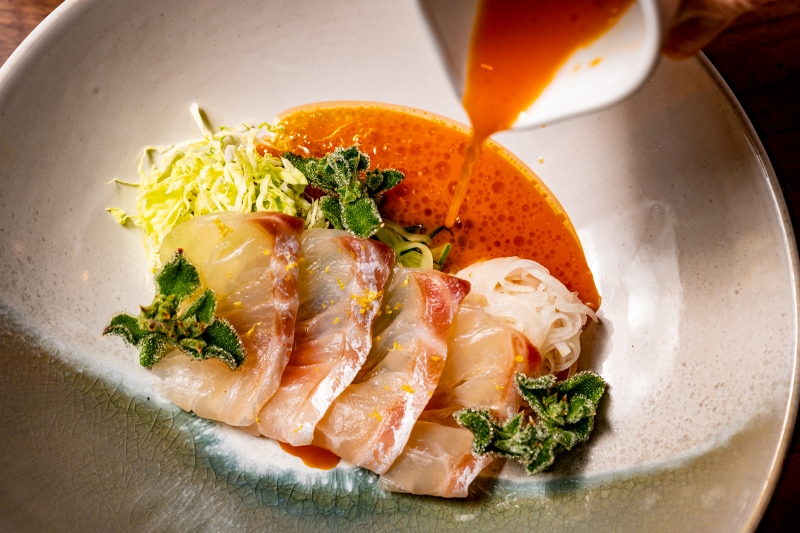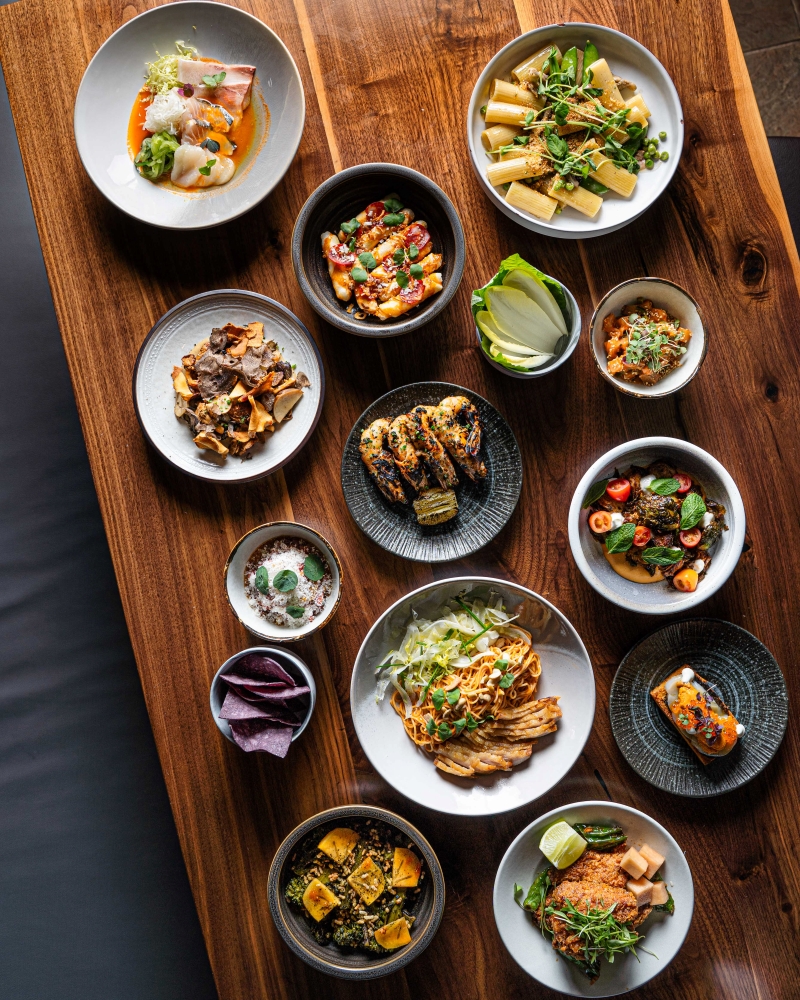- 한국어
- English
- 日本語
- 中文
- العربية
- Español
- Français
- Deutsch
- Pусский
- Tiếng Việt
- Indonesian
By Honorary Reporter Foteini Chatzoudi from Greece
The New York Times every year searches for candidates for its best restaurant lists. Bansang in San Francisco, which blends Korean tradition and innovation, was named to the daily's "23 of the Best American Dishes of 2023" for its Mulhwe (mulhoemyeon), or cold raw fish noodles. The acclaimed eatery is run by the Korean American chefs Ethan Seunghyun Min and Jin Lim.
The following are excerpts from an email interview with both chefs and Min from Dec. 15-20.
Please give a brief background of yourselves.
We are chefs Ethan Min and Jin Lim, both from Korea and proud alumni of the same culinary school at Woosong University in Daejeon.
Min: Upon completing my studies at university, my culinary journey started in Seoul with Gaon. I dedicated myself to developing and perfecting various types of kimchi there while refining the intricate fermentation processes in numerous specialty Korean foods. My culinary preferences expanded over time and my aspirations gradually shifted toward the Western culinary landscape. My growing desire for cultural diversity and the exploration of global cuisines fueled my ambition. San Francisco was the city that resonated with my culinary aspirations, ultimately leading me to the doors of Bansang, from where I now contribute to the culinary scene.
Lim: I was born and raised in the small port city of Pohang, Gyeongsangbuk-do Province. My earliest memories are steeped in the rich tapestry of daily life surrounded by an abundance of seafood. Upon completing my education, my decision was clear: San Francisco was where I wanted to hone my craft not just because of its array of world-class restaurants but also how it resonated with the familiarity of my hometown. I gained valuable experience at renowned establishments such as Michael Mina, Kabuto Sushi and Kinjo in the U.S., but a compelling internal drive prompted me to return to my Korean roots and offer a fresh perspective on my culinary upbringing for an American audience. This led me to open Bansang, where I apply my well-honed skills to deliver an exceptional dining experience night after night with unwavering passion.
What prompted you to pursue a career as a chef?
Min: From a young age, my fascination with food was undeniable. Helping my mom in the kitchen wasn't just assistance but an eager attempt to taste and explore diverse flavors. Cooking became my passion 15 years ago. Seeing the joy on people's faces as they savor our food is indescribable. Korean cuisine in San Francisco wasn't as recognized compared to places like Los Angeles or New York. We noticed a limited perception, primarily of kimchi and Korean BBQ. That drove us to introduce diverse Korean flavors in a familiar way, ensuring Bansang feels inviting to all.
Lim: When I was little, I realized how people easily share their happiness and pleasure when sharing food with friends or family. I discovered how food is the simplest medium that easily connects people. This made me want to become a chef. As a Korean, I wanted to show and share how I feel through the Korean food that I make, so I opened Bansang.
What does your restaurant's name mean?
The term bansang refers to the table setting for Joseon Dynasty royalty, symbolizing the utmost care and sincerity in serving guests. At Bansang, we aim to honor that tradition by extending the same dedication to each of our guests.

Bansang's mulhoemyeon (cold raw fish noodles) was named among The New York Times' "23 of the Best American Dishes of 2023.'' (Pork Belly Studio)
What was your reaction when your dish was named among "23 of the Best American Dishes of 2023" by The New York Times?
We were pleasantly surprised by the recognition. When asked for a picture of the dish, we didn't anticipate it being ranked among the best dishes of 2023. The pride of having mulhoemyeon recognized as a standout dish this year is immense, both for Bansang and for us as Korean chefs.
Give a brief explanation of the dish.
Min: Mulhoemyeon translates to "water and raw fish" in Korean, or a chilled raw fish soup. It's seasonal raw fish in fermented chili broth and seaweed oil, accompanied by savoy cabbage, cured Persian cucumber and pickled Korean radish. The broth is sweet and sour and packs a spicy kick. Mixing everything together and enjoying it as a soup with a spoon offers a delightful blend of textures and flavors.
Do you have a favorite ingredient that you use?
Min: I find mu (Korean radish) an incredibly versatile ingredient in Korean cuisine. Its adaptability to cooking methods fascinates me. With a neutral taste, it splendidly complements other ingredients. We utilize it for pickling, in kimchi, raw, in broth and even for braising. Its raw form has a slight sweetness and crunch with a hint of spiciness, and when cooked, it turns sweeter to offer brilliant flavor and absorb the surrounding flavors beautifully. Its high fiber content also makes it excellent for fermentation, retaining its crunchiness even after the process.

The dishes of Bansang blend Korean tradition and innovation. (Tim Cheung)
What is your restaurant's philosophy?
We are passionate about introducing new Korean flavors in a universally appealing manner. It's disheartening when people limit Korean cuisine to just kimchi and barbecue, unaware of its diverse offerings. While we deeply respect authentic Korean eateries that preserve tradition, we believe that evolving tastes and cultural openness are vital for cuisine to thrive. Bansang aims to be a gateway to Korean cuisine, offering dishes like rice cakes with chorizo and cotija cheese or Korean steak tartare with Parmesan cheese and tortilla chips. This fusion invites everyone, regardless of their familiarity with Korean food, to explore and enjoy new flavors comfortably.
What part of Korean cuisine do you hope that more people discover and appreciate?
Min: Jang culture revolves around fermented soybean products like doenjang (soybean paste), ganjang (soy sauce), gochujang (spicy red pepper paste), ssam jang (mixture of doenjang and gochujang) and more. These form the foundation of Korean cuisine. These foods were traditionally made in earthenware containers called jangdokdae, a process steeped in tradition and reverence. While production methods have evolved in modern times, the meticulousness and respect for the process remain ingrained in Korean culture. This legacy of crafting jang amid auspicious circumstances is something I take immense pride in.
msjeon22@korea.kr
*This article is written by a Korea.net Honorary Reporter. Our group of Honorary Reporters are from all around the world, and they share with Korea.net their love and passion for all things Korean.